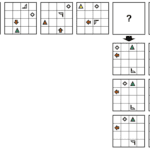TestAS Preparation – Continuing Numerical Series
Continuing Number Series Practice and Tutorials
Continuing Numerical Series – Directives
Continuing Numerical Series
In this task you will see a series of groups of numbers. Each group is a numeric sequence built according to a certain rule. Your task is to find the next number in the sequence indicated by the (?) sign.
You can write the number you think is correct in the answer box and test its correctness with the check button. You can use the practice material an unlimited number of times and without time limit. If the answers you choose are correct, they are marked in green. Once you have found the correct answer, you can continue the exercise with a new question using the Repeat button.
Share With Friends |
||||
| Tweet | ||||
Didn’t find the solution? Here it is!
Would you like to see other question types?
You can also practice other question types in preparation for the TestAS exam. Visit this page for TestAS test preparation strategies.
Continuing Numerical Series – Simple Tips for Solution
The easiest part of the core test in the paper-based TestAS for some and the most difficult for others. This subtest is a test of how well you can perceive numerical relationships. The reason it is called easy: Knowledge of the four basic arithmetic operations of addition, subtraction, multiplication and division is sufficient to answer the questions. The reason why it is called difficult: In some series, the numbers can be very large and the calculation can take a lot of time. Therefore, plenty of practice is required.
Example:
4 8 12 16 20 24 ?
At first glance, it is very clear that each number in the series is found by adding +4 to the previous number. You can easily tell that the question mark should be replaced by 24. Of course, do not expect such easy questions in the exam. I am giving examples to understand the concept of Numerical Series. You will encounter very difficult ones in the exam.
Another example:
4 8 8 11 12 14 ?
This example may seem a bit more complicated at first. But the rule is very simple, there are 2 series here. The 1st and 2nd numbers are the start of two different series. For a better understanding, we show the series in different colors:
4 8 8 11 12 14 ?
The first series starts with the number 4 and the next number is calculated by adding +4 at each step. The second series starts with the number 8 and the next number is calculated by adding +3 at each step. In the given example, since the question mark is an element of the first series (red), it can be calculated by adding +4 to the previous number (12). The correct answer must be 16.
One more example:
4 8 13 19 26 34 ?
In this series, too, the pattern can be relatively difficult to decipher at first glance. However, the rule is simple here too. In the first step, +4 is added to the first number of the series, and in the following steps, the number added is increased by +1. To explain: (4) +4 is added to the first number (4) to get 8, the number added in the next step is increased by +1 and (8) +5 is added to the second number (8) and the series continues in this way. Here, if we look at the last number of the series, we can see that it was calculated by adding +8 to the previous number. Therefore, the correct answer can be calculated by adding (34) +9 to the last number. The correct answer should be 43.
In some series the numbers tend to decrease. In such series, starting from the end of the series to find the pattern will give faster results.
Example:
640 160 156 39 36 9 ?
Since this series has high numbers at the beginning and the series tends to decrease, you should try to find the pattern starting from the end. The last number in the example is one fourth of the previous one. So you should do x4 for the previous number. You can see that the next +4, x4 again and +4 again. When you detect this, it is understood that the series is formed as follows.
640 /4 160 -4 156 /4 39 -4 36 /4 9 -4 5
Examples can be multiplied indefinitely. There are no formulas to memorize in these questions. The questions will be formed with very different patterns. Therefore, plenty of practice will broaden your horizons about possible patterns.
I hope the above explanations will help you. Please share it for the benefit of others. If you have any questions or suggestions, you can reach me at recep[at]recepdayi.com.tr e-mail address and my social media accounts. I wish you all a successful exam.






